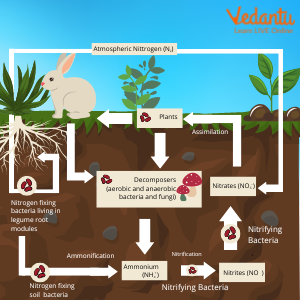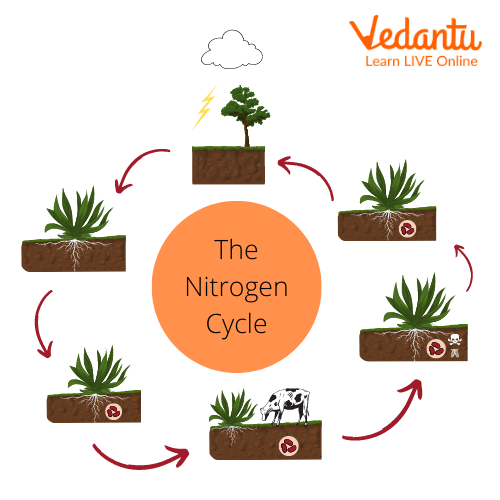




Why Understanding the Nitrogen Cycle Is Essential for Students
The nitrogen cycle is a hydrologic cycle by which nitrogen is translated into different chemical forms as it flows among the atmosphere, terrestrial and oceanic ecosystems. The transformation of nitrogen can be carried out through both biological and physical processes.
Nitrogen is a key nourishing element for plants. Even so, the generous nitrogen in the atmosphere cannot be used directly by plants and animals. The nitrogen cycle makes the utilisation of nitrogen available to plants and other living organisms. Jules Rieset admitted in 1856 that decomposing organic matter releases nitrogen. This location ultimately provided the basis for the nitrogen cycle because it was the first proof of nitrogen cycling in the biological sphere.
The Nitrogen Cycle
The nitrogen cycle expresses how nitrogen works between plants, animals, bacteria, the atmosphere or air, and soil in the ground. It is an essential part of all life on earth. We can remember the nitrogen cycle by the picture ourselves a couple of times, try to make up a story about the diagram that the plant begins to use nitrogen, then the decomposes get in the act, and so on. When a nitrogen generator builds nitrogen gas, the generator does not create nitrogen by itself. Preferably, nitrogen gas present in the air is purified inside the generator.

Nitrogen Cycle Diagram
Why are Bacteria a Necessary Part of the Nitrogen Cycle?
One of the most essential parts of the nitrogen cycle is bacteria. Bacteria help the nitrogen cycle substitute between states so it can be used. When nitrogen is soaked by the soil various bacteria help it to change states so it can be soaked by the plants. Animals then get their nitrogen from the plants.
Nitrogen enters the living universe by way of bacteria and other individual celled prokaryotes which invert atmospheric nitrogen into biologically usable forms. Bacteria are free-living in soil or water. Small microscopic organisms with single cells are called bacteria, they are important for ecosystems as they play a major role in the biochemical process. Bacteria change nitrogen gas from the atmosphere to nitrogen compounds that the plants can soak. That’s why bacteria is a necessary part of the nitrogen cycle.
Nitrogen Cycle Steps
In general, there are five steps of the nitrogen cycle which are as follows:-
Nitrogen Fixation:- Nitrogen must be stable in order to be used by plants
Nitrification:- For those plants who refuse to resolve with Ammonia.
Assimilation:- It is when plants mop up the substances fall asleep by nitrogen fixation and Nitrification.
Ammonification:- Ammonia is made by decaying bacteria.
Denitrification:- If the nitrate ions choose not to combine they depart from the soil and are inverted by limited anaerobic bacteria in water-logged soil and lakes.

Nitrogen Cycle Steps
What is the Role of Bacteria in the Nitrogen Cycle?
Bacteria play a medium role in the nitrogen cycle by the following points:-
Nitrogen-fixing bacteria, change atmospheric nitrogen to nitrates.
Bacteria decompose, which changes decomposing nitrogen waste to ammonia.
Nitrifying bacteria, change ammonia to nitrates.
Denitrifying bacteria, which change nitrates to nitrogen gas.
Fungi-like bacteria help to translate dead plants and animals and their misuse into ammonia in the soil. Plants soak up nitrates from the soil to make proteins. Animals absorb plants and use them to form animal protein.
Summary
In this, we talked about the nitrogen cycle, how it is formed, some best examples, some steps of the nitrogen cycle, and how bacteria play a vital role in the nitrogen cycle. It is better explained by the diagrams.
FAQs on Nitrogen Cycle Explained: Steps, Importance & Examples
1. What is the nitrogen cycle in simple terms?
The nitrogen cycle is the continuous process by which nitrogen is exchanged between living organisms and the non-living environment. It involves nitrogen moving through the atmosphere, soil, water, plants, animals, and bacteria. This cycle converts atmospheric nitrogen, which is mostly unusable by plants and animals, into forms that they can absorb and use to build essential molecules like proteins and DNA.
2. What are the five main stages of the nitrogen cycle?
The nitrogen cycle is primarily driven by bacteria and can be broken down into five main stages:
- Nitrogen Fixation: The process where bacteria convert inert nitrogen gas (N₂) from the atmosphere into ammonia (NH₃).
- Nitrification: The conversion of ammonia into nitrites (NO₂⁻) and then into nitrates (NO₃⁻) by different types of bacteria.
- Assimilation: The process where plants absorb nitrates from the soil through their roots and use them to build proteins and nucleic acids.
- Ammonification: When plants or animals die, decomposers like fungi and bacteria break down the organic nitrogen back into ammonia.
- Denitrification: The process where denitrifying bacteria convert nitrates back into nitrogen gas (N₂), which is then released into the atmosphere, completing the cycle.
3. Why is nitrogen essential for plants and animals?
Nitrogen is a vital component for all living organisms. In plants, it is a major part of chlorophyll, the molecule that enables photosynthesis. For both plants and animals, nitrogen is a fundamental building block of amino acids, which are linked together to form proteins. Proteins are crucial for building tissues, enzymes, and hormones. Nitrogen is also a key element in nucleic acids like DNA and RNA, which carry genetic information.
4. What is the special role of bacteria in the nitrogen cycle?
Bacteria are the primary drivers of the nitrogen cycle, performing chemical conversions that other organisms cannot. Nitrogen-fixing bacteria, like Rhizobium found in the root nodules of leguminous plants, are unique in their ability to convert atmospheric nitrogen into usable ammonia. Nitrifying bacteria then convert this ammonia into nitrates, the form most easily absorbed by plants. Finally, denitrifying bacteria complete the cycle by returning nitrogen gas to the atmosphere.
5. If the atmosphere is about 78% nitrogen, why can't most plants and animals use it directly?
The nitrogen in the atmosphere exists as N₂ gas, where two nitrogen atoms are joined by a very strong triple covalent bond. This bond makes the molecule extremely stable and chemically inert. Most organisms, including all plants and animals, lack the necessary enzymes to break this powerful bond to make the nitrogen atoms available. Only specialised nitrogen-fixing bacteria possess the enzyme nitrogenase, which can break the triple bond and convert atmospheric nitrogen into a biologically useful form.
6. How do human activities like farming and pollution affect the nitrogen cycle?
Human activities significantly alter the natural balance of the nitrogen cycle. The extensive use of nitrogen-based fertilisers in agriculture adds a massive amount of reactive nitrogen to the soil. Excess nitrogen runs off into rivers and lakes, causing eutrophication—algal blooms that deplete oxygen and harm aquatic life. Additionally, the burning of fossil fuels releases nitrogen oxides into the atmosphere, contributing to smog and acid rain.
7. What is the main difference between nitrification and denitrification?
Nitrification and denitrification are essentially opposite processes performed by different types of bacteria. Nitrification is the process that converts ammonia into nitrates (NO₃⁻), making nitrogen available for plants to absorb from the soil. In contrast, denitrification is the process that converts nitrates back into inert nitrogen gas (N₂), removing usable nitrogen from the soil and returning it to the atmosphere.









